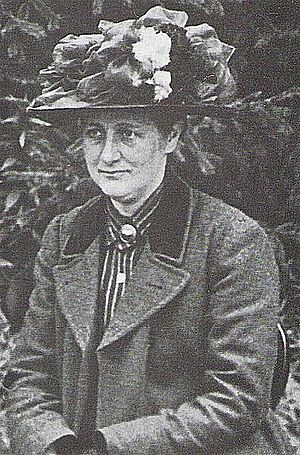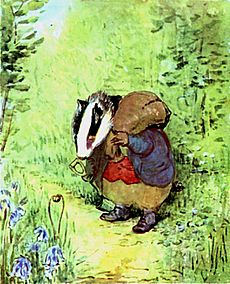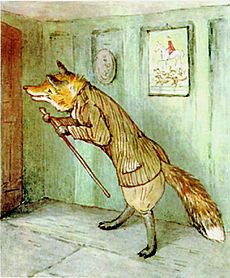The Tale of Mr. Tod facts for kids
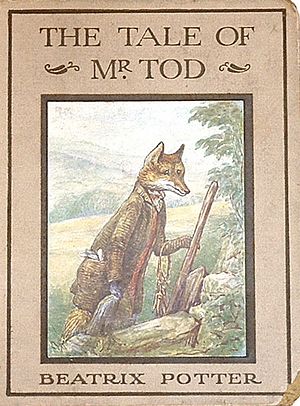
First edition cover (USA)
|
|
| Author | Beatrix Potter |
|---|---|
| Illustrator | Beatrix Potter |
| Country | United Kingdom |
| Language | English |
| Genre | Children's literature |
| Publisher | Frederick Warne & Co. |
|
Publication date
|
1912 |
| Media type | Print (hardcover) |
| Preceded by | The Tale of Timmy Tiptoes |
| Followed by | The Tale of Pigling Bland |
The Tale of Mr. Tod is a classic children's book. It was written and illustrated by Beatrix Potter. The book was first published in 1912 by Frederick Warne & Co.
The story is about a badger named Tommy Brock and his enemy, Mr. Tod, who is a fox. Tommy Brock kidnaps the baby bunnies of Benjamin Bunny and his wife, Flopsy. He plans to eat them and hides them in an oven at Mr. Tod's house. Benjamin and his cousin, Peter Rabbit, follow Tommy Brock. They want to rescue the babies.
When Mr. Tod finds Tommy Brock asleep in his bed, he tries to get him out. Their fight helps the rabbits rescue the baby bunnies. This tale was inspired by the Uncle Remus stories. It is set in the fields of Beatrix Potter's Castle Farm. Many critics think it's one of Potter's best and most exciting stories.
The publisher wanted Mr. Tod to start a new series of Peter Rabbit books. These books would be larger and have fancy covers. Beatrix Potter did not like this idea. Still, Mr. Tod and the next book, The Tale of Pigling Bland, were published in this new style. But the idea was later dropped. These two books were the last completely new stories Potter wrote. She published other books later, but they used old ideas and drawings. In 1995, an animated film of the story was shown on the BBC TV show The World of Peter Rabbit and Friends.
Contents
Creating the Story
Beatrix Potter bought Hill Top Farm in 1905. This farm was in Lancashire, which is now Cumbria. After buying the farm, she wrote and drew many popular children's books. But by 1910, she was getting tired of writing for children. Her eyesight was not as good, and she was busy with her farm and caring for her parents.
In 1912, she brought Peter Rabbit and his family together one last time. This was for The Tale of Mr. Tod. Potter felt her editors were too careful. She knew she could create more exciting characters and plots. In Mr. Tod, she introduced two "bad" characters: Mr. Tod the fox and Tommy Brock the badger.
The Tale of Mr. Tod and The Tale of Pigling Bland (from 1913) were her last completely new works. She married William Heelis in October 1913. This slowed down her writing career. She still published books sometimes, but she used old drawings and ideas.
How the Book Was Made
This story is longer than Potter's earlier tales. It was partly inspired by the Uncle Remus stories. The setting for Mr. Tod is the real countryside around Sawrey. This includes places like Bull Banks and Oatmeal Crag. These were two fields Potter bought in 1909. The book has more black and white drawings than color ones.
Potter's publisher, Harold Warne, received the story in November 1911. He wasn't sure about using the name 'tod' for a fox. Potter explained that "tod" was a common old word for a fox. She said "brock" was also an old country name for a badger. She told him these words were still used in places like Westmoreland.
The story is about characters who are not always "good." Warne did not like Potter's first sentence. She had written: "I am quite tired of making goody goody books about nice people. I will make a book about two disagreeable people, called Tommy Brock and Mr. Tod." He changed it to: "I have made many books about well-behaved people."
Potter told him she thought her original opening was good. She liked that it was different from "once upon a time." She also joked with him about the name Bull Banks. She said farmers don't mind words like "bulls," but he seemed sensitive to some words. The story was finished in July.
The spring of 1912 was a difficult time for Potter. Her father was sick, and there were big strikes across the country. In April 1912, she went to Hill Top to draw backgrounds for the story. By July, most of the color pictures were done. Potter was careful about drawing the fox correctly. She looked at photos and books at the Natural History Museum. She wanted to make sure she drew a real English red fox.
The book was finished by the end of July. Potter also spent time fighting against hydroplanes on Lake Windermere. She also opposed building an airplane factory near the lake.
The Tale of Mr. Tod was published in 1912. It was dedicated to Francis William. He was the two-year-old son of her cousin Caroline.
The publisher wanted to make Mr. Tod the first of a new series. These books would be slightly larger with fancy covers. Potter did not want a new series. Her eyesight was getting worse, and she was tired of writing. She felt children liked books that didn't change much. Even so, Mr. Tod and The Tale of Pigling Bland were published in this new, larger style. Potter didn't like the new pictures inside the covers. Eventually, the larger size and new style were stopped. The books went back to their usual look.
Story Plot
The story starts with Tommy Brock, a badger, visiting old Mr. Bouncer. Mr. Bouncer is Benjamin Bunny's father. He is watching his grandchildren while Benjamin and Flopsy are away. Mr. Bouncer smokes his pipe and falls asleep. Tommy Brock puts the baby bunnies in his sack and leaves quietly. When Benjamin and Flopsy return, Benjamin goes after the thief.
Benjamin finds his cousin Peter Rabbit. They both go to rescue the babies. They discover Tommy Brock has gone into one of Mr. Tod's houses. Mr. Tod, the fox, has many homes and moves often. Tommy Brock sometimes stays in his houses. The rabbits peek through a window and see Tommy asleep in Mr. Tod's bed. They look through the kitchen window and see a table set for a meal. They realize the bunnies are alive, but locked in the oven.
They try to dig a tunnel into the house. But they hide when Mr. Tod suddenly arrives. He is in a very bad mood and has moved house. The fox finds the badger asleep in his bed. He first plans to hit him, but then changes his mind. He decides to play a trick. He balances a bucket of water above Tommy's bed.
But Tommy Brock is awake. He avoids the trick and goes to make tea in the kitchen. Mr. Tod thinks the bucket killed Tommy. He decides to bury him in the tunnel the rabbits dug, thinking Tommy dug it. When Mr. Tod finds Tommy in the kitchen, Tommy throws tea on him. A big fight starts and moves outside. The two roll down the hill, still fighting. Benjamin and Peter quickly grab the bunnies. They all go home happily.
Pictures in the Book
The Tale of Mr. Tod is longer than most of Potter's other stories. It has 16 color pictures and 42 black and white drawings. There is one drawing on each page. The pictures show the real places around Near Sawrey. These include Bull Banks, Oatmeal Crag, and Esthwaite Water. The inside of Mr. Tod's house shows details of village homes.
In the first picture, Mr. Tod stands on a stone floor. The wall behind him is made of wood and painted green. His kitchen has a tea caddy, a silver salt shaker, and blue and white china. The beehive-shaped brick oven is drawn from a real oven at the Sun Inn in Hawkshead. This is where Brock hides the bunnies.
The black and white pictures have strong frames. They look a bit like woodcuts. Potter believed a black frame made a picture look complete. She made the kitchen dim in some pictures. This was to hide some of the details of the fight between Tod and Brock.
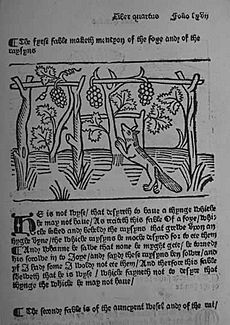
Some experts say the black and white pictures make the story feel old and important. They have thick black lines. These lines are different from Potter's usual delicate style. These pictures look more like woodcuts than drawings. They were carefully planned to give the story an old, simple feel. This is like the woodcuts in Caxton's old books of Aesop's Fables.
The color pictures do not have thick black lines. They have a white border. This keeps the soft pastel colors from blending into the background. The light pastel colors and green tones are different from the strong black and white pictures. This difference makes the story feel both old and lasting. It is like how the greenness of nature returns each season.
How the Story Was Adapted
Mr. Tod was made into an animated show. It was part of the BBC TV series, The World of Peter Rabbit and Friends. Dinsdale Landen was the voice of Tod. Don Henderson was the voice of Brock.
British writer Mark Huckerby voiced Mr. Tod in a British/American computer-animated TV series. Mr. Tod and Tommy Brock were voiced by Fayssal Bazzi and Sam Neill in the live-action/CGI animated film Peter Rabbit.
Images for kids
-
Caxton's "The Fox and the Grapes", 1484


